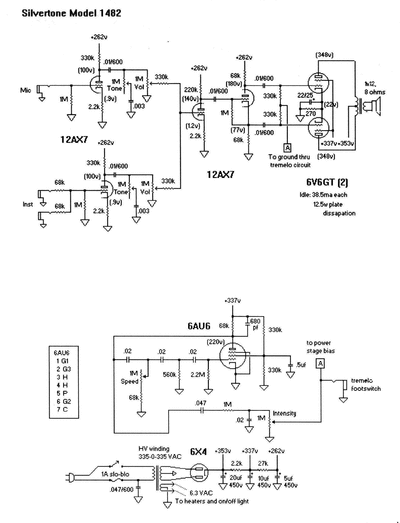Hello guys.
In a previous thread I described the main issue in my 1966 Silvertone 1482 amp: due to power tranny miswiring I had low heater voltages i.e., around 5.9 Vac.
I ended taking the tranny to a tech who rewound it following the specs that I drew from the schematic diagram (see attached image).
Out of the circuit the rewound tranny is right on specs, that is: 335 Vac from the HV winding and a bold 6.5 Vac from the heater winding.
Trouble comes when I hook it to the chassis with all the tubes in place: with 230 Vac supply provided by a variac, HV is about 30 Vac less (same for Vdc readings at the main three filter caps and for the plate voltage on each 6V6 tube) and the heater voltage is a mere 6.0 Vac. The only right readings are plate voltages on the two preamp tubes.
What is wrong with this amp? I know that the circuit 'eats' some voltage if compared with the unhooked PT readings, but is voltage supposed to get SO low?
Did I make a mistake giving the tech the readings that I read from the schematic? If so, how should I act the next time I need a tranny rewinding?
--Carlo

In a previous thread I described the main issue in my 1966 Silvertone 1482 amp: due to power tranny miswiring I had low heater voltages i.e., around 5.9 Vac.
I ended taking the tranny to a tech who rewound it following the specs that I drew from the schematic diagram (see attached image).
Out of the circuit the rewound tranny is right on specs, that is: 335 Vac from the HV winding and a bold 6.5 Vac from the heater winding.
Trouble comes when I hook it to the chassis with all the tubes in place: with 230 Vac supply provided by a variac, HV is about 30 Vac less (same for Vdc readings at the main three filter caps and for the plate voltage on each 6V6 tube) and the heater voltage is a mere 6.0 Vac. The only right readings are plate voltages on the two preamp tubes.
What is wrong with this amp? I know that the circuit 'eats' some voltage if compared with the unhooked PT readings, but is voltage supposed to get SO low?
Did I make a mistake giving the tech the readings that I read from the schematic? If so, how should I act the next time I need a tranny rewinding?
--Carlo

 And I didn't provide the tech with a schematic
And I didn't provide the tech with a schematic 
Comment